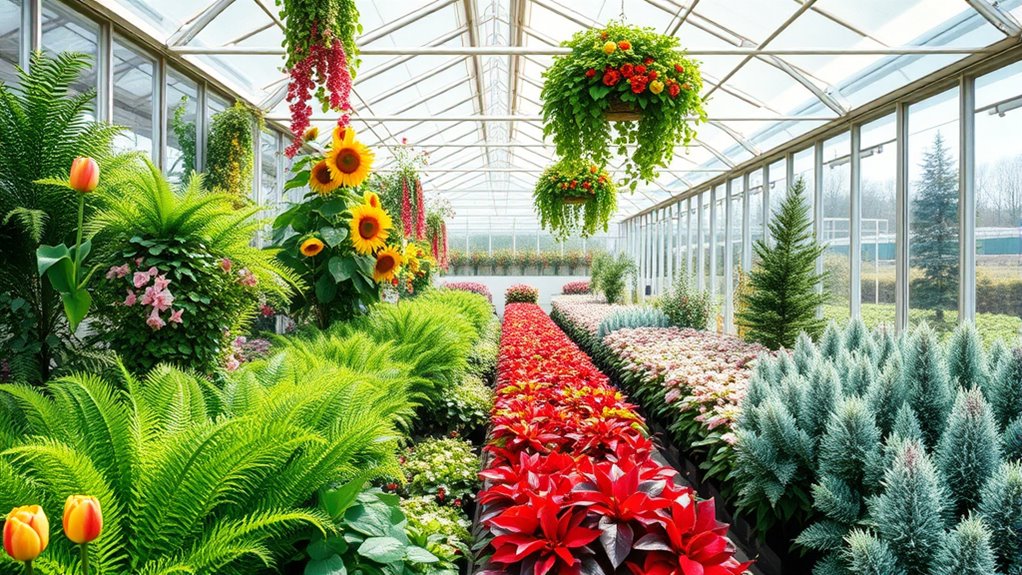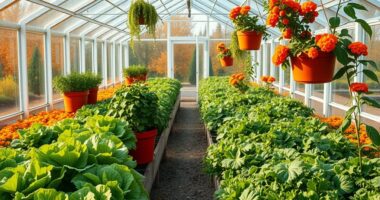To keep your greenhouse lively year-round, choose spring bloomers like daffodils and tulips that thrive in early warmth. For summer, opt for tropical plants and succulents that handle heat and drought. Fall favorites include maples and chrysanthemums, while winter greens like kale and spinach flourish in cooler months. Incorporate herbs for every season, plus fruit trees and exotic plants for added variety. Explore more tips to optimize your greenhouse’s seasonal treasures.
Key Takeaways
- Choose spring bloomers like tulips and daffodils, and use pollination techniques to enhance flowering and fruiting.
- Select fall foliage plants such as maples and dogwoods, and incorporate seasonal color plants like chrysanthemums and asters.
- Grow summer heat lovers like tropical foliage and succulents for year-round resilience and vibrant displays.
- Cultivate winter-hardy greens like kale, spinach, and herbs such as parsley and thyme for continuous harvests.
- Include exotic tropical plants and low-maintenance succulents to add visual interest and adaptability across all seasons.
Spring Bloomers to Brighten Your Greenhouse
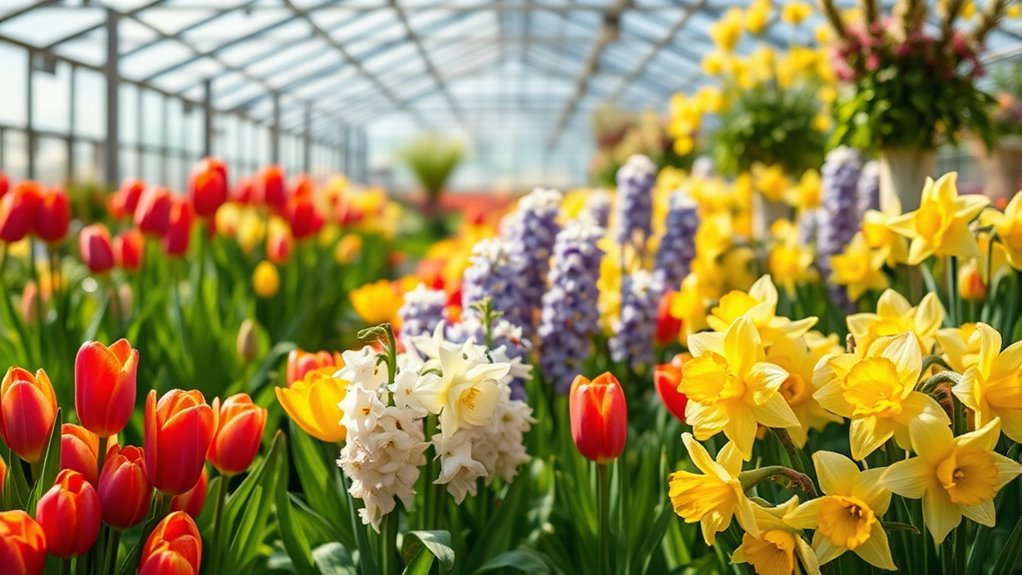
As winter ends and temperatures begin to rise, it’s the perfect time to introduce spring bloomers into your greenhouse. To guarantee successful flowering, focus on pollination techniques, such as gentle hand pollination or using a small brush to transfer pollen. Proper pollination boosts flower production and fruit set. Additionally, maintaining ideal greenhouse humidity control is essential; spring bloomers often thrive in moderate humidity levels, which prevent disease and encourage healthy growth. Use a hygrometer to monitor moisture levels and adjust ventilation or misting accordingly. Proper humidity levels are crucial for preventing mold and pests that can hinder plant development. Furthermore, selecting plants with high light requirements will ensure vibrant blooms during this season. Incorporating automated climate control systems can help maintain optimal environmental conditions, reducing manual adjustments and promoting consistent plant health. Research indicates that consistent environmental management significantly enhances flowering success and plant vitality.
Summer Heat Lovers for Year-Round Growth
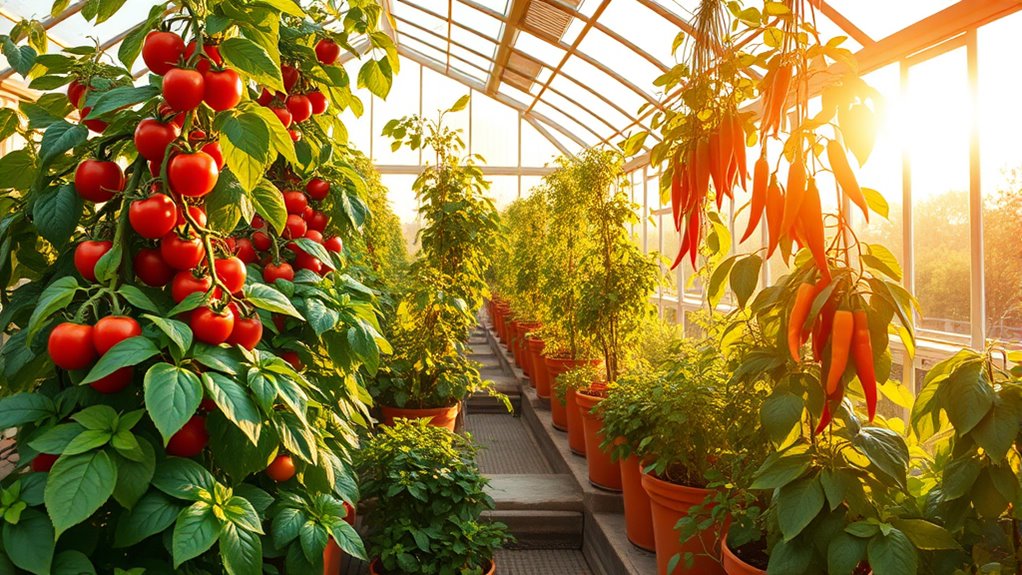
With the arrival of summer, many plants thrive in the heat, making it the perfect time to focus on heat-loving species that can sustain growth throughout the year.
Look for shade-tolerant plants that can handle high temperatures without wilting, ensuring your greenhouse remains vibrant even during the hottest days. These plants often attract pollinators, so choosing pollinator-friendly species benefits your entire ecosystem.
Choose shade-tolerant, heat-resistant plants to keep your greenhouse vibrant and attract pollinators year-round.
Consider options like certain ferns, succulents, and tropical foliage that flourish in warm, sunny conditions but also tolerate partial shade.
Incorporating these summer heat lovers helps maintain a lush, productive greenhouse year-round. Plus, their adaptability to high temperatures and appeal to pollinators make them excellent choices for a thriving, resilient garden no matter the season.
Fall Foliage and Colorful Plants
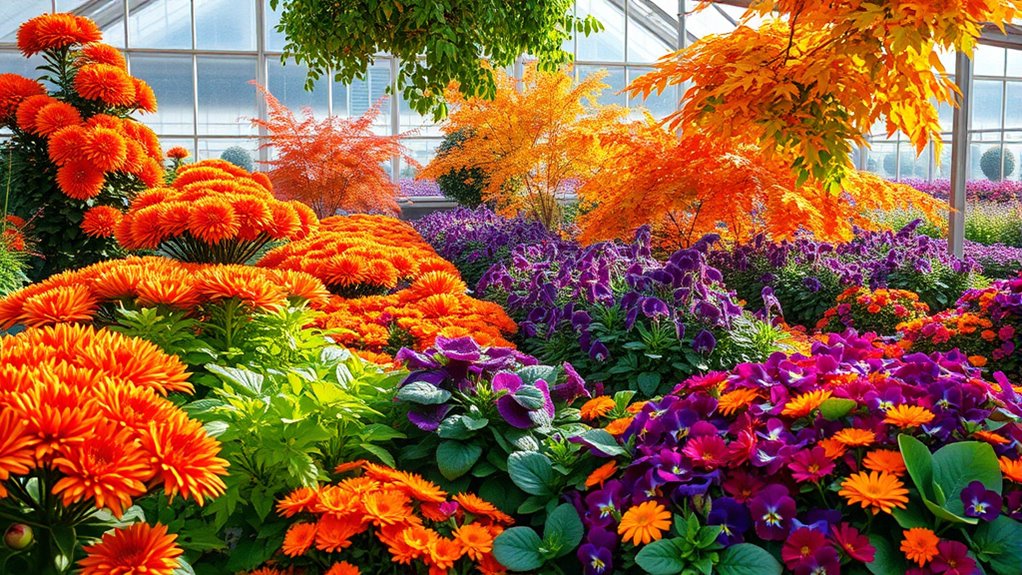
As fall arrives, you’ll notice vibrant leaf colors transforming your landscape with stunning reds, oranges, and yellows. Choosing seasonal flower varieties can add even more color and interest during this time. To keep your plants looking their best, follow simple care tips tailored for autumn conditions. Incorporating seasonal water plants can also enhance your greenhouse’s visual appeal and support a healthy environment during the cooler months. Additionally, selecting plants that promote biodiversity can help create a resilient and vibrant greenhouse ecosystem. Being aware of symptoms of plant stress can help you address issues early and maintain healthy growth. Remember that user privacy policies ensure your browsing experience remains secure and personalized while exploring different plant options. Maintaining active listening with your plants and environment can help you better understand their needs and adapt your care accordingly.
Vibrant Leaf Colors
Have you ever marveled at the brilliant hues that autumn transforms your landscape into? Fall foliage displays an incredible spectrum of leaf colors, from fiery reds and fiery oranges to golden yellows. To bring vibrant leaf colors into your greenhouse, choose plants known for their striking fall foliage. Maples, with their vivid red leaves, are a classic choice, while certain dogwoods and sweetgums showcase stunning color shifts. Be sure to include varieties that naturally develop vibrant hues as temperatures drop. These plants not only add visual interest but also create a warm, inviting atmosphere during the cooler months. Incorporating high-quality plants that thrive in seasonal changes will ensure your greenhouse remains colorful year-round.
Seasonal Flower Varieties
When planning your garden for the fall, incorporating seasonal flower varieties can dramatically enhance its color palette. To succeed, start with seasonal soil preparation by enriching your soil with compost and organic matter. Use plant propagation techniques like cuttings or division to expand vibrant options like chrysanthemums, asters, and mums. These techniques ensure healthy growth and plentiful blooms. Consider planting bulbs such as tulips and daffodils in early fall for spring color. Arrange your flowers thoughtfully, mixing textures and hues for a striking display. Here’s a quick guide:
| Flower Type | Propagation Method |
|---|---|
| Chrysanthemums | Cuttings or division |
| Asters | Seed or cuttings |
| Daffodils | Bulb planting |
| Ornamental Kale | Seed or transplants |
Additionally, understanding the importance of seasonal planning can help you create a more cohesive and vibrant garden display. Proper plant care during the fall ensures your plants remain healthy and thrive through the season. Incorporating personal development techniques such as visualization and goal setting can also inspire you to create a beautiful, flourishing garden that reflects your creativity and dedication.
Plant Care Tips
To keep your garden vibrant through the fall, focus on caring for your foliage and colorful plants. Start by enriching your soil with appropriate soil amendments to guarantee your plants have the nutrients they need for healthy fall color. Regularly inspect your plants for pests, and manage any infestations promptly to prevent damage. Proper pest management helps maintain the vibrancy of your foliage and prevents disease spread. Water your plants deeply but avoid overwatering, especially as temperatures drop. Mulching around the base of plants conserves moisture and insulates roots. Keep dead or yellowing leaves removed to improve air circulation and reduce disease risk. Incorporating mindful plant care practices can create a more tranquil and thriving garden environment. Being aware of seasonal changes can help you adjust your plant maintenance routines effectively. By staying attentive to soil health and pest control, your fall plants will display their best colors and remain healthy throughout the season. Paying attention to mindfulness during garden maintenance can further enhance your connection with nature and promote overall plant health. Additionally, understanding the importance of soil amendments can significantly improve plant vigor during seasonal changes. Regularly testing your soil’s pH and nutrient levels can also help you make targeted soil adjustments for optimal plant growth.
Winter Hardy Greens and Vegetables
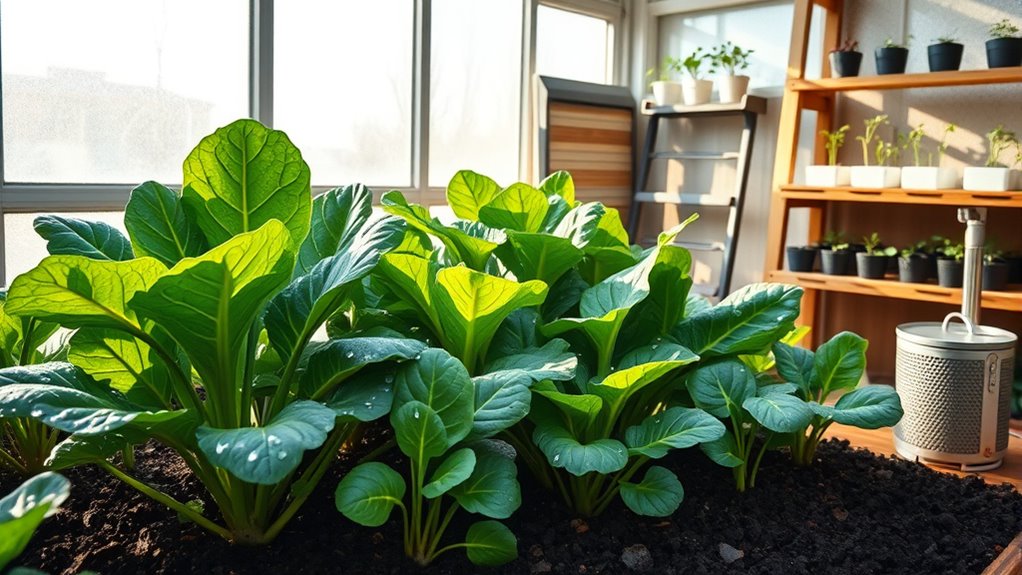
Despite the cold temperatures, many greens and vegetables thrive outdoors during winter, providing fresh produce even in the coldest months. Hardy greens like kale, collards, and spinach are excellent choices for winter gardens. To boost their resilience, consider companion planting; for example, planting onions or garlic nearby can help deter pests naturally. Using effective pest control techniques, such as row covers or organic repellents, keeps these plants healthy without chemicals. Incorporating companion planting methods can further enhance plant health and yield. These methods minimize pest issues and promote a thriving winter garden. Additionally, selecting varieties bred for cold tolerance ensures successful harvests.
Furthermore, choosing appropriate soil conditions and mulching around plants can improve insulation and moisture retention, supporting healthy growth during cold months.
With proper planning, your winter garden can yield nutritious greens and vegetables, keeping your diet fresh and vibrant even when outdoor temperatures drop.
Best Herbs to Grow in Every Season

Ever wondered which herbs can thrive in each season? Your herb garden offers a variety of medicinal plants suited to different times of the year.
In spring, basil and chives flourish, adding flavor and healing properties to your culinary and medicinal uses.
Summer is ideal for growing herbs like cilantro and mint, which thrive in warm weather and support digestion and relaxation.
During fall, try rosemary and sage—they’re hardy and perfect for preserving flavors or medicinal teas.
In winter, hardy herbs like thyme and parsley can survive indoor conditions, providing fresh leaves year-round.
Choosing the right herbs for each season guarantees a continuous supply of fresh medicinal plants, making your herb garden not only flavorful but also a natural remedy source throughout the year.
Fruit-Bearing Plants for Continuous Harvests
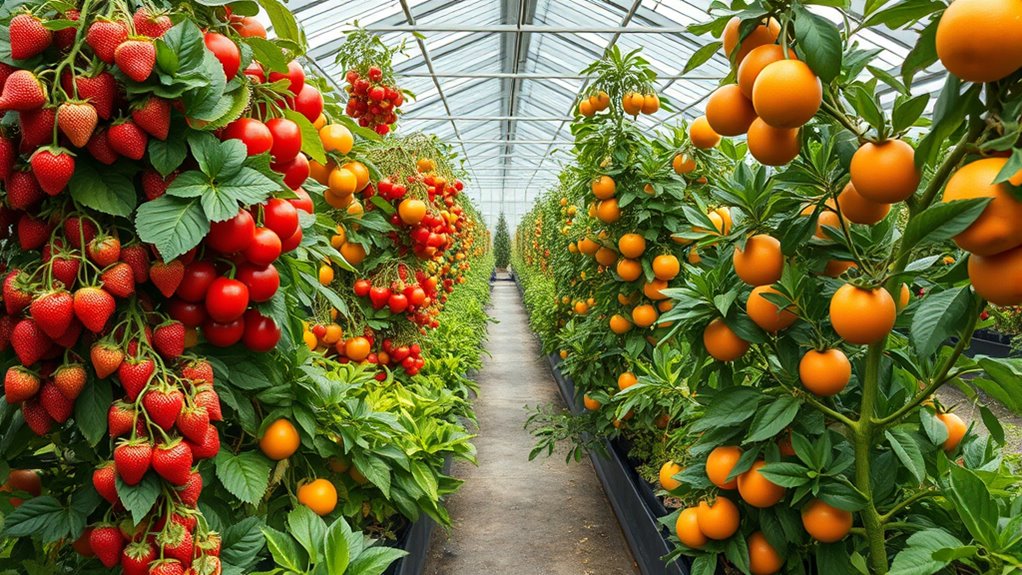
To enjoy fresh fruit year-round, you’ll want to select plants that produce across different seasons.
Staggering your planting times guarantees a continuous harvest, so you can pick ripe fruit whenever you need it.
With the right strategy, you’ll have fresh fruit on hand no matter the time of year.
Year-Round Fruit Options
Growing fruit year-round is possible with the right selection of plants that can produce continuously or stagger their harvests. To guarantee consistent yields, focus on fruit-bearing plants that are adaptable to indoor conditions, like dwarf citrus or fig trees.
Proper pollination techniques are essential; hand pollination or introducing beneficial insects can improve fruit set.
Additionally, soil sterilization methods help prevent soil-borne diseases, promoting healthy growth and fruit production. Regularly sterilize your soil to eliminate pathogens and pests, creating a clean environment for your plants.
Choose varieties suited for indoor cultivation that can produce fruit in a controlled environment. With the right pollination strategies and soil management, you can enjoy fresh, homegrown fruit throughout the year.
Staggered Planting Strategies
Implementing staggered planting strategies can guarantee a steady supply of fresh fruit throughout the year. By planting fruit-bearing plants at different intervals, you ensure continuous harvests.
To maximize success, focus on proper soil preparation—adding organic matter improves soil health and supports healthy growth. Incorporate companion planting to optimize space and deter pests naturally. For example, plant strawberries alongside herbs like basil or spinach, which benefit both crops.
Regularly stagger your planting dates, so as one batch matures, another is starting to grow. This approach minimizes downtime and prevents overloading your greenhouse.
With careful planning and attention to soil and plant combinations, you’ll enjoy a consistent, abundant harvest of fresh fruit all year long.
Exotic and Tropical Plants for All Seasons

Exotic and tropical plants bring vibrant color and lush texture to your garden year-round, regardless of the season. You can enjoy tropical fruits like bananas and pineapples inside your greenhouse, adding both beauty and fresh flavors.
Exotic orchids, with their intricate blooms and striking appearances, thrive in warm, humid environments and brighten any space. These plants are adaptable for all seasons, provided you maintain consistent warmth and humidity.
Tropical foliage such as philodendrons and monsteras also add lush greenery that creates a tropical paradise vibe. With proper care, you turn your greenhouse into a vibrant oasis where exotic plants flourish and bring a touch of the tropics to your everyday life.
Succulents and Cacti for Low-Maintenance Seasons
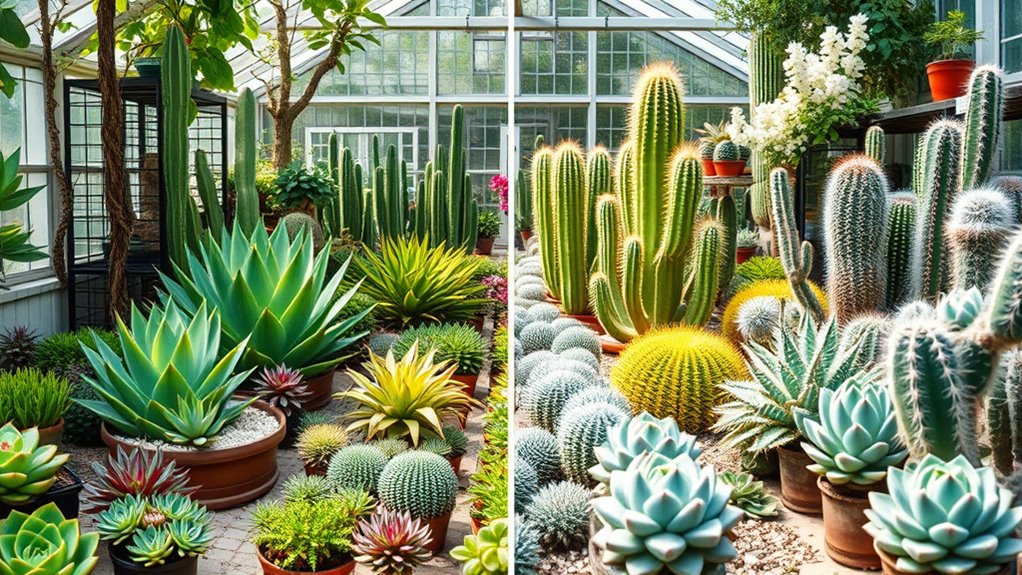
If you’re looking for a low-maintenance way to keep your garden lively year-round, succulents and cacti are perfect choices. These plants thrive with minimal watering and care, making them ideal for busy seasons. You can create stunning succulent arrangements that add texture and color to your greenhouse.
To keep your plants healthy, follow simple cactus care tips: guarantee well-draining soil, avoid overwatering, and provide plenty of sunlight. Succulents and cacti also tolerate dry conditions well, so they’re perfect for low-humidity environments.
Their unique shapes and low upkeep make them a practical and attractive option during low-maintenance seasons. With minimal effort, you’ll enjoy vibrant greenery and fascinating textures all year long.
Frequently Asked Questions
How Do I Select the Right Plants for My Specific Greenhouse Environment?
To select the right plants for your greenhouse, start by evaluating your greenhouse climate, including temperature, humidity, and light levels.
Then, focus on plant compatibility, choosing species that thrive under your specific conditions.
Research each plant’s needs and match them to your environment.
This way, you’ll guarantee healthy growth and a thriving greenhouse, tailored to your climate and the plants’ requirements.
What Are Common Pests and Diseases Affecting Seasonal Greenhouse Plants?
Imagine you notice yellowing leaves on your tomato plants in spring. Common pests like aphids can attack, spreading diseases if not managed.
To prevent this, practice pest prevention by regularly inspecting plants and using natural predators or organic sprays.
For disease management, keep your greenhouse clean and reduce humidity.
Staying vigilant helps protect your plants from pests and diseases, ensuring healthy, thriving seasonal greenhouse crops.
How Can I Optimize Watering Schedules for Different Seasonal Plants?
To optimize watering schedules, you should monitor soil moisture regularly and modify your watering frequency accordingly.
For seasonal plants, check if the soil feels dry a few inches below the surface, then water deeply.
Avoid overwatering to prevent root rot, and guarantee proper drainage.
Adjust your watering routine based on seasonal changes—more frequent in summer, less in winter—so your plants stay healthy and thrive year-round.
Which Fertilizers Are Best Suited for Each Season’S Plants?
Imagine nourishing your plants just right—fertilizer timing matters. You’ll want a balanced, slow-release fertilizer during less active seasons like winter to meet seasonal nutrient needs.
While spring and summer call for higher nitrogen formulas to promote growth. Adjust your approach based on plant type and growth stage.
How Do I Prevent Seasonal Plant Stress During Temperature Fluctuations?
To prevent seasonal plant stress during temperature fluctuations, focus on effective seasonal plant care by implementing temperature regulation techniques. You can use heaters or fans to maintain a stable environment, and insulate your greenhouse during extreme weather.
Monitoring temperatures regularly helps you adjust conditions quickly. Additionally, shade cloths or vents help prevent overheating or cold drafts, ensuring your plants stay healthy and resilient despite changing temperatures.
Conclusion
No matter the season, your greenhouse becomes a vibrant symphony of life, each plant playing its part in the grand orchestra of growth. With the right choices, you’re the conductor guiding this lush melody through spring’s bloom, summer’s warmth, fall’s color, and winter’s quiet. Embrace the ever-changing dance of nature inside your sanctuary, and watch your greenhouse transform into a living masterpiece—your personal garden of eternal wonder.
